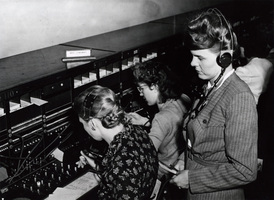 | Back to e-WV
| Back to e-WV
 The West Virginia Encyclopedia
The West Virginia Encyclopedia
 | Back to e-WV
| Back to e-WV
 The West Virginia Encyclopedia
The West Virginia Encyclopedia

In 1879, three years after Alexander Graham Bell first demonstrated the telephone, West Virginia’s first telephone line was strung in Wheeling. The private line connected two grocery stores owned by the Behrens brothers. On May 15, 1880, the state’s first exchange was placed in service, also in Wheeling. The new telephone system started with about 25 subscribers. At first they could make only local calls, but long-distance service was started between Wheeling and Pittsburgh in 1883.
Telephone exchanges were soon added in other cities. Switchboards were installed in Parkersburg in 1882; Charleston in 1883; Huntington in 1884; Moundsville in 1884; Martinsburg in 1886; Grafton in 1890; Clarksburg in 1891; Bluefield in 1893; Fairmont in 1894; and Morgantown in 1896. Soon after the exchanges had been established, toll lines were constructed to connect the various central offices in the state. By 1889, all of the exchanges in northern West Virginia had been interconnected.
In 1897, the American Telephone & Telegraph Company extended a long-distance line from Cuyahoga Falls, Ohio, through Point Pleasant to Charleston. The line provided a connection to the exchanges in the northern part of the state. Another long-distance line was constructed through West Virginia in 1901. With terminating points at Petersburg, Virginia, and Georgetown, Kentucky, this line provided service to Charleston and Huntington, along with other cities located along the Kanawha and Ohio rivers. Construction of toll and long-distance lines through the rest of the state soon created a network to almost every section.
Highlights in the development of telephone service include the introduction of dial service in 1925 in Huntington and direct distance dialing in Wheeling and Moundsville in 1956. In 1984, Charleston became the first city in the U.S. to be able to choose long-distance carriers other than AT&T. As the nation’s test market, customers chose a company among eight serving the area with long-distance service.
In 1916, the Chesapeake & Potomac Telephone Company & Potomac of West Virginia was incorporated. C&P provided the majority of telephone service throughout the state. It was part of the Bell System, whose parent was AT&T. When telephone service was deregulated, AT&T agreed in the 1980s to divest itself of the Bell operating companies that provided local service. The national telephone system was replaced by a newly structured AT&T and seven regional Bell operating companies. C&P became part of Bell Atlantic Corporation, now Verizon.
Verizon was the largest telephone company in West Virginia until 2010, when the Public Service Commission approved the sale of its land lines to Frontier Communications. Previously Frontier had served a minority of West Virginia customers, and the Armstrong, West Side, War, Spruce Knob Seneca Rocks, and Hardy telephone companies continue to serve a small fraction of the population.
Long-distance service is now provided by regular landline carriers, with AT&T still the prevalent company. After Verizon gained federal approval to offer long distance in 2003, more West Virginia customers began buying bundles of local and long-distance service offered by the local provider. In the early 21st century, customers increasingly abandon landlines and traditional long distance service for cellular providers—estimated at more than one-half of customers.
More than 20 companies provide wireless or cellular telephone service to West Virginians. Cingular merged with AT&T Wireless in 2004 to become the largest wireless provider in the state. Today, the state’s largest wireless providers are AT&T, Sprint, and Verizon.
Technology has dramatically changed the telephone industry. Fiber-optic cables, introduced in the 1980s, are capable of carrying much more data than conventional copper wire, and most long-distance lines are now fiber optic. The use of cellular phones has grown rapidly since they first became available in the Mountain State in the 1980s. Telecommunications companies provide service to customers in West Virginia through nearly five million access lines. Telephone companies now also provide cable television and Internet services. A second area code (681) was introduced in 2009 to supplement West Virginia’s long-standing 304 area code.
Written by Judie Smith